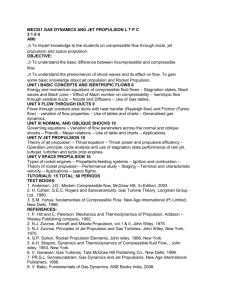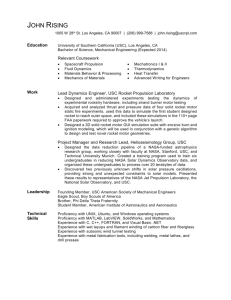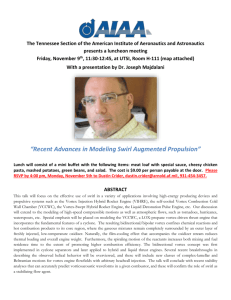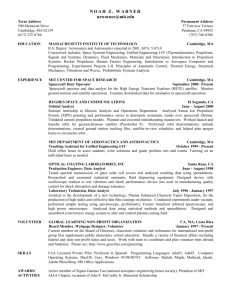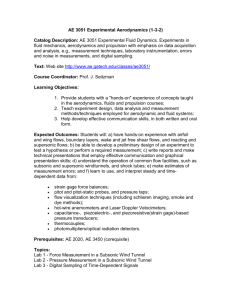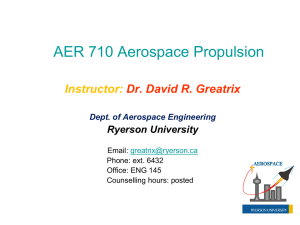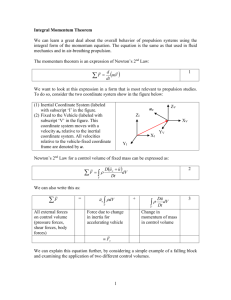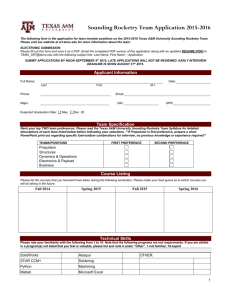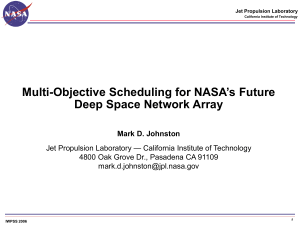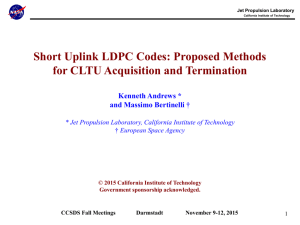File - SRIT - MECHANICAL ENGINEERING
advertisement
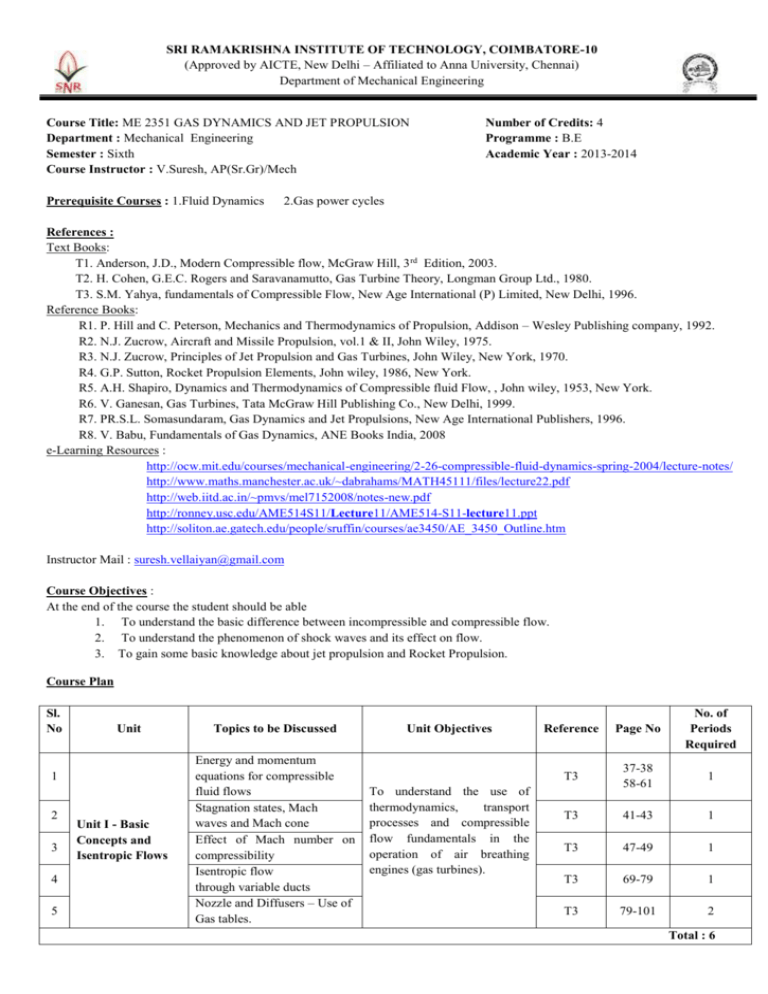
SRI RAMAKRISHNA INSTITUTE OF TECHNOLOGY, COIMBATORE-10 (Approved by AICTE, New Delhi – Affiliated to Anna University, Chennai) Department of Mechanical Engineering Course Title: ME 2351 GAS DYNAMICS AND JET PROPULSION Department : Mechanical Engineering Semester : Sixth Course Instructor : V.Suresh, AP(Sr.Gr)/Mech Prerequisite Courses : 1.Fluid Dynamics Number of Credits: 4 Programme : B.E Academic Year : 2013-2014 2.Gas power cycles References : Text Books: T1. Anderson, J.D., Modern Compressible flow, McGraw Hill, 3 rd Edition, 2003. T2. H. Cohen, G.E.C. Rogers and Saravanamutto, Gas Turbine Theory, Longman Group Ltd., 1980. T3. S.M. Yahya, fundamentals of Compressible Flow, New Age International (P) Limited, New Delhi, 1996. Reference Books: R1. P. Hill and C. Peterson, Mechanics and Thermodynamics of Propulsion, Addison – Wesley Publishing company, 1992. R2. N.J. Zucrow, Aircraft and Missile Propulsion, vol.1 & II, John Wiley, 1975. R3. N.J. Zucrow, Principles of Jet Propulsion and Gas Turbines, John Wiley, New York, 1970. R4. G.P. Sutton, Rocket Propulsion Elements, John wiley, 1986, New York. R5. A.H. Shapiro, Dynamics and Thermodynamics of Compressible fluid Flow, , John wiley, 1953, New York. R6. V. Ganesan, Gas Turbines, Tata McGraw Hill Publishing Co., New Delhi, 1999. R7. PR.S.L. Somasundaram, Gas Dynamics and Jet Propulsions, New Age International Publishers, 1996. R8. V. Babu, Fundamentals of Gas Dynamics, ANE Books India, 2008 e-Learning Resources : http://ocw.mit.edu/courses/mechanical-engineering/2-26-compressible-fluid-dynamics-spring-2004/lecture-notes/ http://www.maths.manchester.ac.uk/~dabrahams/MATH45111/files/lecture22.pdf http://web.iitd.ac.in/~pmvs/mel7152008/notes-new.pdf http://ronney.usc.edu/AME514S11/Lecture11/AME514-S11-lecture11.ppt http://soliton.ae.gatech.edu/people/sruffin/courses/ae3450/AE_3450_Outline.htm Instructor Mail : suresh.vellaiyan@gmail.com Course Objectives : At the end of the course the student should be able 1. To understand the basic difference between incompressible and compressible flow. 2. To understand the phenomenon of shock waves and its effect on flow. 3. To gain some basic knowledge about jet propulsion and Rocket Propulsion. Course Plan Sl. No Unit 1 2 3 4 5 Unit I - Basic Concepts and Isentropic Flows Topics to be Discussed Energy and momentum equations for compressible fluid flows Stagnation states, Mach waves and Mach cone Effect of Mach number on compressibility Isentropic flow through variable ducts Nozzle and Diffusers – Use of Gas tables. Unit Objectives To understand the use of thermodynamics, transport processes and compressible flow fundamentals in the operation of air breathing engines (gas turbines). Reference Page No No. of Periods Required T3 37-38 58-61 1 T3 41-43 1 T3 47-49 1 T3 69-79 1 T3 79-101 2 Total : 6 8 9 Flows through constant area ducts with heat transfer (Rayleigh flow) Flows through constant area ducts with heat transfer and Friction (Fanno flow) variation of flow properties Use of tables and charts 10 Generalised gas dynamics. 6 7 Unit II- Flow Through Ducts Perform a numerical simulation of compressible flow through a variable area duct. Describe assumptions, physical meaning of terms and utilize key relationships for compressible flow, speed of sound, isentropic and nonisentropic flows T3 247-266 T3 T3 T3 2 2 211-246 2 1 2 Total : 9 11 Governing equations 12 Variation of flow parameters across the normal shocks 13 Unit III - Normal and Oblique Shocks Variation of flow parameters across the oblique shocks 14 Prandtl – Meyer relations 15 Use of table and charts – Applications. Describe physically why shock waves exist and explain the difference between normal, oblique, stationary and moving shock waves Use the normal shock tables to solve problems in supersonic flow in which normal shocks are present. T3 1 134-173 T3 3 T3 3 T3 174-210 T1 1 2 Total : 10 16 Theory of jet propulsion 17 Thrust equation power and efficiency 18 Unit IV - Jet Propulsion 19 20 – Thrust propulsive Operation principle of ram jet Cycle analysis and use of stagnation state performance of ram jet Operation principle of turbojet, turbofan and turbo prop engines Apply control volume analysis and the integral momentum equation to estimate the forces produced by aerospace propulsion systems. Describe the principal figures of merit for aircraft engine and rocket motor performance and explain how they are related to vehicle performance. T3 T3 1 357-366 2 T3 1 T3 4 366-395 T3 2 Total : 10 21 Types of rocket engines 22 Propellants-feeding systems 23 Ignition and combustion 24 Theory of rocket propulsion – Performance study Unit V - Space Propulsion 25 Staging – Terminal and characteristic velocity 26 Applications – space flights Provide students with the ability to analyze the performance of gas turbine cycles and rocket engine cycles for space propulsion. Describe the principal design parameters and constraints that set the performance of rocket engines, and to apply ideal-cycle analysis to a gas turbine engine to relate thrust and fuel burn to componentlevel performance parameters and flight conditions. T3 1 396-414 T3 1 T3 1 T3 2 T3 414-459 T3 3 2 Total : 10 Additional Contents over and above the curriculum: 27 Module I Multi-Dimensional Flow Perform a numerical simulation of various Coordinate Systems T3 269-301 4 Total : 4 Total duration required : 60 periods + 6 periods for Tests = 66 Periods Assignments Assignment: A1. Explain the concept of Fanno flow and Rayleigh flow Submission Deadline for A1 : 19.02.2014 A2. Explain the concept of Aircraft propulsion and Rocket Propulsion Submission Deadline for A2 : 17.03.2014 Case study C1.Measurement methods of flow parameters. Submission Deadline for C1 :07.04.2014 Course Assessment Plan: 1. Internal Assessment (20) Internal Assessment Test 1 will be conducted for 50 Marks. (5*2=10 & 2*20=40) Internal Assessment Test 2 will be conducted for 50 Marks. (5*2=10 & 2*20=40) Internal Assessment Test 3 will be conducted for 50 Marks. (5*2=10 & 2*20=40) Tests as per the schedule given by the university – Average of three tests are considered for assessment out of 15. Course Attendance Assessment out of 5 ( Attendance percentage 96-100 : 5; 91-95 : 4; 86-90 : 3; 81-85 : 2; 76-80 : 1) 2. External Assessment (80) University will conduct end semester examination for 100 marks (10*2=20 & 5*16=80) Performance will be considered for assessment out of 80. PEOs : This Course is conducted to achieve the following Programme Educational Objectives (PEOs): • PEO 1. Be able to apply the principles of Mechanical engineering to solve real time problems and succeed in their career. • PEO 2.Be able to contribute and communicate effectively in multidisciplinary projects and perform services related to mechanical engineering to meet the customer requirements in both quality and quantity. • PEO 3.Be able to update the modern trends in engineering and technology through continuous learning and be the leaders in their profession. Program Outcomes (POs) PO1: An ability to solve basic Engineering problems by applying mathematics, science, and engineering fundamentals. PO2: An ability to conduct Investigations using design of experiments, analysis and interpretation of data to arrive at valid conclusions. PO3: An ability to design a mechanical engineering component and processes within economic, environmental, ethical and manufacturability constraints. PO4: Ability to identify, formulate, analyze and solve Mechanical Engineering Problems. PO5: An ability to communicate effectively through written reports or oral presentations. PO6: An ability to understand the impact of engineering solutions in a global, economic, environmental, professional and societal context. PO7: An ability to recognize the need and to engage in independent and life-long learning. PO8: An ability to have knowledge of contemporary issues PO9: An ability to use the appropriate techniques and modern engineering tools necessary for engineering practice. PO10: An ability to apply the principles of management to manage projects Multidisciplinary environment. Course Outcome: At the End of the Course , a student will be able to 1. Understand the basic difference between incompressible and compressible flow. 2. Understand the phenomenon of shock waves and its effect on flow. 3. Gain some basic knowledge about jet propulsion and Rocket Propulsion. Mapping : PO1 PO2 PO3 PO4 PO5 PO6 PO7 PO8 PO9 PO10 CO1 CO2 CO3 Course Instructor HOD-MECH PRINCIPAL
